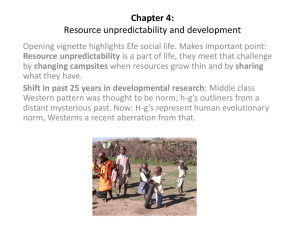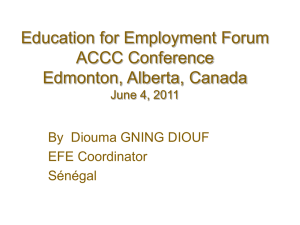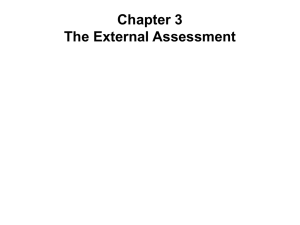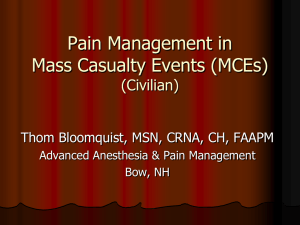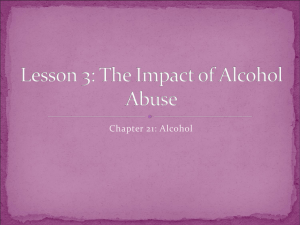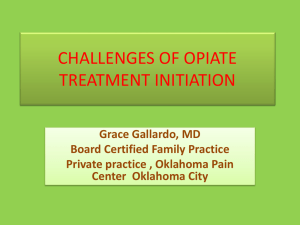here - Université catholique de Louvain
advertisement
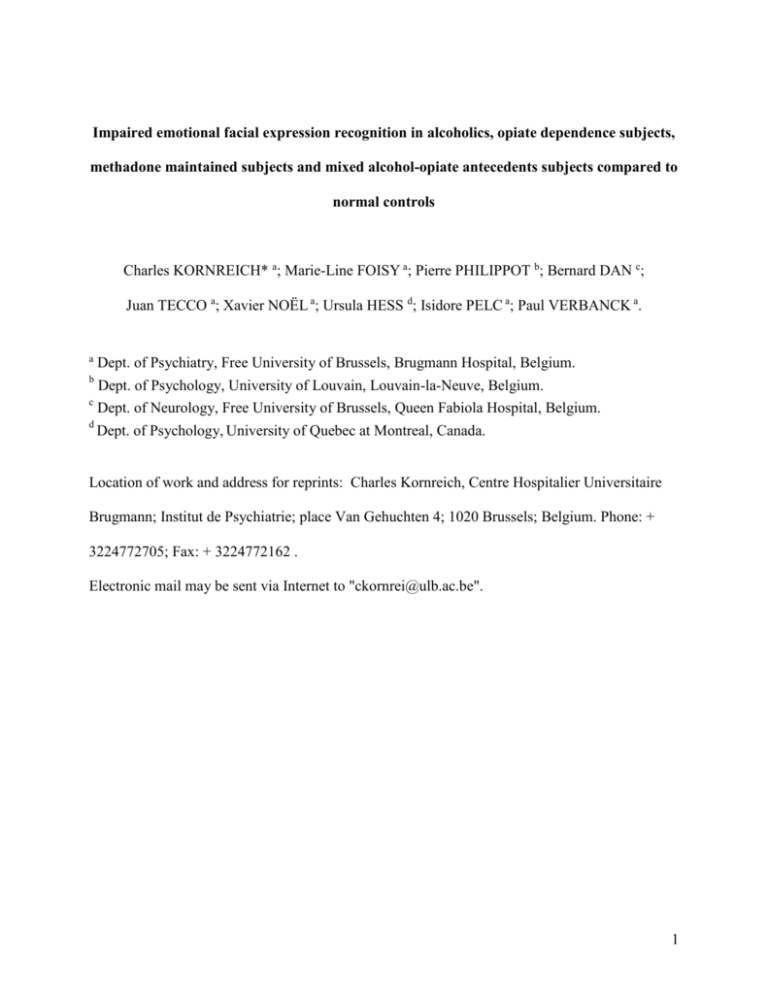
Impaired emotional facial expression recognition in alcoholics, opiate dependence subjects, methadone maintained subjects and mixed alcohol-opiate antecedents subjects compared to normal controls Charles KORNREICH* a; Marie-Line FOISY a; Pierre PHILIPPOT b; Bernard DAN c; Juan TECCO a; Xavier NOËL a; Ursula HESS d; Isidore PELC a; Paul VERBANCK a. a Dept. of Psychiatry, Free University of Brussels, Brugmann Hospital, Belgium. Dept. of Psychology, University of Louvain, Louvain-la-Neuve, Belgium. c Dept. of Neurology, Free University of Brussels, Queen Fabiola Hospital, Belgium. d Dept. of Psychology, University of Quebec at Montreal, Canada. b Location of work and address for reprints: Charles Kornreich, Centre Hospitalier Universitaire Brugmann; Institut de Psychiatrie; place Van Gehuchten 4; 1020 Brussels; Belgium. Phone: + 3224772705; Fax: + 3224772162 . Electronic mail may be sent via Internet to "ckornrei@ulb.ac.be". 1 Abstract Objective: The present study aims to explore whether emotional facial expressions (EFE) decoding impairment is specific to alcoholism compared to opiate dependence. Method: A EFE decoding test consisting of 16 photographs of EFE portraying happiness, anger, sadness and disgust was administered to 5 different groups of 30 subjects each: recently detoxified alcoholics (RA), opiate addicts under methadone maintenance treatment (OM), detoxified opiate addicts (OA), detoxified subjects with both alcohol and opiate dependence antecedents (DAO) and normal controls (NC). Repeated measure analysis of variance using a multivariate approach was conducted on EFE decoding accuracy scores with group as betweensubjects factor. Results: Accuracy scores were significantly lower in RA and DAO than in OM and OA, which had significantly lower scores than NC Conclusion: Low accuracy scores in RA and DAO confirm previous results indicating that alcoholism is associated with impaired EFE recognition. Results in OM and OA indicate that opiate dependence is also associated with impaired EFE decoding but less so than in alcohol using groups. Alcohol and opiate chronic consumption could both exercise a deleterious effect on EFE decoding brain function, alcohol having the most severe impact. Alternatively, EFE decoding problems could be present before the development of alcohol and opiate dependence, with an additional effect of chronic alcohol consumption on EFE decoding. In this context, EFE decoding impairment could reflect a more general emotional intelligence deficit in addicted populations. Key words: Emotion, Face, Alcohol, Drug, Nonverbal 2 1. Introduction Alcoholics are frequently confronted with interpersonal problems even when sober (Nixon et al., 1992), these problems representing a major cause of relapse (Marlatt, 1996). Good interpersonal relationships depend, among other factors, on the ability to accurately decode nonverbal signals from communicating partners (Carton at al., 1999). Awareness of the partners’ feelings, allows to tune one’s reactions and to ensure good interpersonal communication (Patterson, 1999). Therefore, alcoholics’ interpersonal problems could be partly linked to impaired processing of emotional information related to social interactions. Previous evidence supports this hypothesis: The ability to accurately decode affective prosody, a nonlinguistic aspect of language that conveys emotion and attitude during discourse, is altered in alcoholics (Monnot et al., 2001). Furthermore we found poor emotional facial expression (EFE) decoding abilities in recently detoxified alcoholics (Philippot et al., 1999; Kornreich et al., 2001a) and in alcoholics abstinent for at least two months (Kornreich et al., 2001b). Inaccurate affect recognition has also been described in other psychiatric disorders like schizophrenia (Poole et al., 2000; Ross et al., 2001; Streit et al., 2001). This deficit has been proposed to account for poor interpersonal functioning in schizophrenic patients (Poole et al., 2000; Streit et al., 2001) supporting the idea that social interpersonal difficulties may be related to nonverbal decoding dysfunction in certain psychiatric populations. This is consistent with the association we found between poor EFE decoding abilities and higher scores of interpersonal difficulties in recently detoxified alcoholics (Kornreich et al., 2001c). EFE decoding problems in alcoholics could result from the toxic effect of alcohol on the brain. Indeed, regions that are thought to be implicated in the EFE decoding process are also preferentially affected by chronic alcohol consumption (Kornreich et al., 2001b). Alternatively 3 EFE decoding difficulties could precede the onset of alcohol dependence and constitute a vulnerability factor. It is currently not known if other addictions than alcoholism are also associated with impaired EFE decoding. In this study, we compared alcoholics to different groups to contribute to answering this question. A methadone maintained group was studied to investigate the influence of continuous opiate use. An opiate detoxified group was used to inquire whether eventual EFE disturbances persist with abstinence in this population. Finally, we examined a group with both opiate and alcohol dependence antecedents in order to investigate a currently frequently encountered clinical population and a possible additive deleterious effect of both substances. 2. Method 2.1. Participants Thirty inpatients (18 men and 12 women) diagnosed with alcohol dependence according to DSM IV criteria (RA) were recruited in the psychiatric ward of a large University Hospital in Brussels, Belgium, at the end of their detoxification process. They were in their third week of inpatient stay and were not taking any psychotropic medication at the time of assessment. Ninety inpatients diagnosed with actual or past opiate dependence according to DSM IV criteria were recruited either in the same hospital or at a long-stay post-detoxification treatment center (Trempoline, Châtelet, Belgium) characterized by a maximum possible stay of 18 months. Thirty of them (25 men and 5 women) were under methadone maintenance treatment (OM) and thirty others (22 men and 8 women) had been detoxified from opiates for 2 days to 15 months (mean=3.80 months and SD= 4.43 months) (OA). These 60 participants had never met DSM IV criteria for alcohol dependence. Finally, the 30 remaining participants (26 men and 4 women) 4 were diagnosed with both opiate addiction and alcohol dependence antecedents (DAO). They were taking no alcohol for at least 3 weeks. Four of them were still under methadone maintenance treatment. The others had not taken opiates for at least 2 days (mean=11.59 months; SD= 25.84 months). Abstinence for all study participants was ensured both by staff’s clinical supervision and by frequent urine and/or alcohol breath test controls. In order not to test demented patients, all inpatients whether alcoholics or / and opiate addicts were screened for overt cognitive dysfunction through the clinical observation of the staff (nursing observation but also medical and psychological evaluation) regarding their ability to correctly function during their hospitalization (ability to find their way, to be oriented in time, to express themselves properly and to retain information). The non-patient control group (NC) (16 men and 14 women) consisted of 30 volunteers with neither psychiatric record nor alcoholism or opiates consumption antecedents. The NC group has been recruited among the hospital staff employees and in the investigators’ social environment. All groups were further assessed with the Beck Depression Inventory (BDI) (Beck et al., 1988) and historical variables as control measures. BDI was used to control the possible effect of the depression variable on EFE decoding accuracy. Historical variables were recorded for all inpatients: age, gender, educational level, familial history of addiction (alcoholism or drugs), daily alcohol consumption, number of previous inpatients detoxification stays, length of disease, history of substances used (alcohol, tobacco, cannabis, benzodiazepines, heroine, methadone, cocaine, amphetamines, hallucinogens, inhalants), HIV seropositivity, head injury antecedents and overdose history (i.e.unconscious states following massive drug ingestion needing medical intervention). Education was coded as 5 follows: 1= post secondary school training, 2= completion of secondary school or equivalent, 3= completion of the 3 first years of secondary school or equivalent. Presence of at least one first-degree relative (father and/or mother) with alcohol dependence or opiate dependence was considered as evidence of a positive familial history. Antecedents for substance use are recorded when participants report regular use. A description of the samples is shown in Table 1. After complete description of the study to the subjects, written informed consent was obtained. The ULB (Université Libre de Bruxelles) ethical board has approved this research project. -------------------------------------------------------Insert about here Table 1 -------------------------------------------------------2.2. Procedure A series of EFE constructed by Hess and Blairy (1995) was used. These authors selected facial expressions of happiness, anger, sadness, disgust and fear performed by two male and two female Caucasian actors from a series of standardized EFE (Matsumoto and Ekman, 1988). A series of intermediate expressions differing in emotional intensity level by 10% steps was constructed based on the neutral face (0% of emotional intensity level) and the full-blown emotional facial expression (100% of emotional intensity level) of the same actor using the computer program Morph 1.0. From this series, a set of 2 (Intensity levels: 30% and 70%) x 4 (Emotions: happiness, anger, disgust and sadness) x 2 (actors) stimuli constituted the stimulus 6 material. These 16 stimuli were presented in a random order on an Apple Macintosh PowerBook 1800. We limited the number of expressions presented in order not to overwhelm the subjects. The 30% and 70% intensity levels were chosen as they are more frequently encountered in real-life situations than full-blown expressions. After completion of the decoding task, participants filled in the Beck Depression Inventory (Beck et al., 1988) and the historical questionnaire. 2.3. Dependent measures Facial expression decoding Each of the 16 expression exemplars was rated by participants on seven-point intensity scales. Eight different emotions were presented as choices (to expand upon the four target emotions): happiness, sadness, fear, anger, disgust, surprise, shame and contempt. The subject ranked each of the 16 facial stimuli on each of the 8 intensity scales that ranged from 1 = ‘not at all’ to 7 = ‘very intensely’ (see example on figure 1). Image of the face remained on the screen until all scales were completed. After completion of emotion rating of each expression, participants also rated the task’s difficulty on a seven point scale from 1 corresponding to ‘very easy’ to 7 corresponding to ‘very difficult’. This additional measure was used to evaluate the subjects’ awareness of eventual deficits in decoding EFE. Decoding accuracy was defined as the observer’s ability to correctly infer the portrayed emotion. An expression was considered as accurately identified when the emotion scale rated with the highest intensity score corresponded to the target emotion. An accurately identified expression received a score of 1 and a misidentified expression received a score of 0. 7 -------------------------------------------------------Insert about here Figure1 -------------------------------------------------------2.4. Data analysis All statistical analyses were conducted by using Statistical Package for the Social Sciences (SPSS), version 10.0.7a for Macintosh. All statistical tests were two-tailed. Unless otherwise specified, p<0.05 was assumed to define statistical significance. Results of continuous variables are expressed as means and standard deviations. Emotional accuracy scores and emotional difficulty scores showed a normal distribution and therefore were treated with parametric tests. Correlations for preliminary analyses used the Pearson product-moment correlation coefficient (r). Moreover, between-group comparisons and within-group comparisons were conducted by using either one-way analysis of variance (ANOVA) for continuous variables, or chi-square statistic test for categorical variables. Statistical differences among the 5 different groups on (1) the emotional test accuracy scores and (2) the emotional test difficulty scores were evaluated by repeated measure analyses of variance using a multivariate approach with Emotion (happiness, anger, sadness and disgust) and Intensity (30% and 70%) as within-subjects factors, and Group (RA, OM, OA, DAO and NC) as between-subjects factor. However, in the context of the present paper, only main effects or interactions involving Group are of interest and we shall limit our presentation and discussion to these results. Post-hoc comparisons were conducted by using one-way ANOVA 8 3. Results 3.1. Preliminary Analyses No significant correlation was found between depression scores and age, on the one hand, and decoding accuracy scores, on the other hand. No significant correlation was found between length of consumption and length of abstinence for the different substances used and performance in the emotional test. Therefore it was not necessary to control for their effects (e.g. with analysis of covariance). Likewise, no gender, educational level, overdose, head injury antecedents, familial antecedents significant main effect or interaction was observed. Therefore, all subsequent analyses were collapsed across these factors. 3.2. Decoding accuracy In order to assess whether alcoholics showed a difference in the ability to decode EFE compared to the other groups, a repeated measure analysis of variance using a multivariate approach was conducted. As can be seen in Table 2, the results revealed a significant main effect of Group. Accuracy scores as a function of groups are displayed in Figure 2. Among the interactions involving Group, none of them accounted for a large percentage of variance (as indicated by 2). Therefore, we focused the analysis on the main effect of Group and not the subsequent second and third order interactions that explain less variance. 9 -------------------------------------------------------Insert about here Table 2 -------------------------------------------------------- -------------------------------------------------------Insert about here Figure 1 -------------------------------------------------------- Post hoc analysis revealed that compared to NC (mean=.49; SD=.12), all other groups were less accurate for the decoding of EFE. However, among the addicted groups, OM (mean=.41; SD=.16) and OA (mean=.40; SD=.16) had comparable results and were significantly more accurate than RA (mean=.33; SD=.15) and DAO (mean=.30; SD=.16). These latter two groups did not differ. Post-hoc analyses are shown in table 3. -------------------------------------------------------Insert about here Table 3 -------------------------------------------------------- 3.3. Difficulty Repeated measure analysis of variance using a multivariate approach was conducted on difficulty ratings. 10 2 The results revealed a significant main effect of group: F=3,149; df=4,145; p<.05 ; =.080 ; Power=.810 (RA: mean= 3.325; SD= 1.06; OM: mean= 3.096; SD= 1.12; OA: mean= 2.579; SD= .90; DAO: mean= 3.471; SD= 1.19; NC: mean= 3.133; SD= .91) No interactions involving Group reached significance. Post-hoc analysis revealed that OA evaluate the task as easier than NC (F=5.604; df=1,58; p<.05; 2=.088), RA (F=8.607; df=1,58; p<.01; 2=.129) and DAO (F=10.665; df=1,58; p<.01; 2=.155). Other post-hoc comparisons between groups did not reach significance. 4. Discussion We found that accuracy scores are significantly lower in RA and DAO versus NC. OM and OA display scores between DAO and RA on the one hand and NC and the other hand. Difficulty scores show that patients’ groups are not aware of their deficits as reflected by the fact that they judge the task to be as difficult or even easier than NC. Accuracy scores in patients displaying alcohol dependence antecedents whether recently detoxified as for RA or with varying lengths of abstinence as in DAO are in accordance with our previous studies showing EFE decoding difficulties in recently detoxified alcoholics and in alcoholics abstinent for at least two months (Philippot et al., 1999; Kornreich et al., 2001a; 2001b). OM and OA display intermediate results between RA and DAO on the one hand and NC on the other hand. This pattern could indicate that opiates have a deleterious impact on brain functions 11 necessary to process EFE but less so than alcohol. Alternatively, EFE decoding difficulties could precede addictions in general and be worsened by chronic alcohol consumption. OM and OA display similar EFE accuracy scores. The length of abstinence in OA does not influence these scores. This suggests either that opiates per se do not have an impact on EFE decoding function or that deleterious effects persist well after opiate discontinuation. Psychomotor and cognitive functions do not appear to be impaired by the chronic use of morphine, codeine, heroin or methadone (Lombardo et al., 1976; Rousaville et al., 1982; Zacny, 1995; Specka et al., 2000). This contrasts with the well-known deleterious effects on cognitive functioning of chronic alcohol consumption (Parsons, 1998) or of poly-substance abuse in patients using, among other substances, alcohol (Selby and Azrin, 1998). When methadone maintenance patients exhibit poorer performances on several neuropsychological domains like information processing, attention, problem solving, verbal and visual memory, other factors seem to account for most of the results observed (Darke et al., 2000). These factors are mainly a history of alcohol dependence, repeated exposure to overdose and traumatic head injury antecedents (Darke et al., 2000). HIV seropositivity in drug abusers has also been implicated as a risk factor to develop cognitive difficulties in this population (Silberstein et al., 1987; 1993; Avants et al., 1997). However, neither heroin nor methadone seems to be neurotoxic per se. (Darke et al., 2000). Our population was HIV seronegative. The incidence of traumatic head injuries was low and did not influence the results. Overdose antecedents were more common but had no impact on EFE test results. If EFE decoding impairment in OM and OA are neither due to toxic effects of opiate chronic abuse, nor to commonly recognized factors of cognitive impairment in this population 12 (i.e traumatic head injury, overdose and HIV seropositivity), they may have been present before the addiction began. Emotional disturbances and communication difficulties have been described in populations at risk to develop an addiction such as children of drug-abusing parents (Brown and Zuckerman, 1991) or children of alcoholics (Drake and Vaillant, 1988; Sher et al., 1991; Jones and Houts, 1992; Segrin and Mize Menees, 1996). Genetic factors may influence the development of addiction (Cloninger et al., 1981; Kendler et al., 2000). Although difficult to prove (Nelson and De Haan, 1997), there are also some indications (Emde et al., 1992; Davis et al., 1994) that genetic factors could influence the development of EFE decoding skills. Thus it is conceivable that genetic factors could influence either separately or together the development of an addiction and the ability to read nonverbal signals. On the other hand, disturbed social and emotional interactions between alcoholic or drugabusing parents and their children could also account for the emotional difficulties encountered in these specific populations (Guo et al., 1994). Interestingly the same kind of mechanism i.e. exposure to early inappropriate emotional exchanges has been proposed to explain the development of alexithymia, a sort of emotional blindness commonly found in addicted patients (Haviland et al., 1988; Handelsman et al., 2000). Alexithymia, a personality construct defined as a difficulty to be aware of one’s own emotions has been suggested to be a risk factor to develop substance abuse (Finn et al., 1987; Kauhanen et al., 1992; Helmers and Mente, 1999) and to promote relapse in abstinent patients (Loas et al., 1997). As there is clinical and empirical evidence that individuals with high degrees of alexithymia experience difficulties in accurately identifying emotions in the facial expressions of others (Parker et al., 1993; Lane et al., 1996), we would suggest that the impaired EFE decoding 13 abilities we observed might be part of a more general emotional intelligence deficit in alcoholics and opiate addicts. The toxic effect of chronic alcohol consumption or of combined alcohol and drug use on brain regions implicated in the decoding of EFE could be responsible for the more severe EFE decoding disturbances seen in RA and DAO. Our findings should be viewed in the context of the study’s methodological limitations. It was not possible to match the subjects of the different groups for age or education level. Alcoholics are usually older than opiate addicts and matching them could thus create a bias, isolating particular subpopulations. However, neither age nor education level had an influence on EFE decoding test in our previous studies (Philippot et al., 1999; Kornreich et al., 2001a; 2001b; 2002), nor has it on this one. Gender could be an issue, women being usually credited with better non-verbal decoding performances than men (Hall, 1984). However, we did not find a gender effect on accuracy scores with the EFE test we used, neither in this study nor in previous studies (Philippot et al., 1999; Kornreich et al., 2001a; 2001b; 2002). But it must be noted that the small respective samples in the patients’ groups preclude any firm conclusion regarding the respective susceptibility of male and female patients to have impaired EFE processing. We did not use other cognitive measures as control measures. However, our interest here was to compare pathological groups between them on EFE function. Other cognitive variables could covariate with EFE accuracy scores or serve as mediating factors but this would not change the conclusions of our study that accuracy deficits are present in all patient groups and more pronounced in the groups characterized by chronic alcohol consumption antecedents. Group heterogeneity regarding the substances used and abstinence duration seems a limitation very difficult to overcome: isolating groups with identical characteristics would require considerable populations on the one hand and would lead to very selective subpopulations on the 14 other hand engendering difficulties to generalize the results obtained to more ecological conditions. We did not use an alcohol group with long-term abstinence in this study. However, this was done previously (Kornreich et al., 2001b) and revealed that, even if some improvement is observed, there is still significant EFE decoding impairment after long-term abstinence. In conclusion, EFE decoding impairments are present both in opiate addicts and alcoholics. These disturbances could be due to the toxic effect of chronic substance consumption. They could also be part of a more general emotional intelligence deficit, be present early on and constitute a risk factor to develop an addiction through their detrimental effects on interpersonal relationships. EFE decoding impairments are more severe in groups with chronic alcohol consumption antecedents, possibly reflecting an additional deleterious effect of this substance on non-verbal decoding abilities. Acknowledgements This project was supported by the ‘Fonds de la Recherche Scientifique Médicale Belge’ n° 3.4613.01 The authors thank Laurence Sayette, Georges van der Straten and Sylvie Blairy for their help. 15 References Avants, S.K., Margolin, A., McMahon, T.J, Kosten, T.R. 1997. Association between self-report of cognitive impairment in HIV status, and cocaine use in a sample of cocaine-dependent methadone-maintained patients. Addictive Behavior 22, 599-611. Beck, A.T., Steer, R., Garbin, M., 1988. Psychometric properties of the Beck depression inventory: twenty-five years of research. Clinical Psychology Review 8, 77-100. Brown, E.R., Zuckerman, B., 1991. The infant of the drug-abusing mother. Pediatric Annals 20, 555-563. Carton, J.S., Kessler, E.A., Pape, C.L., 1999. Nonverbal decoding skills and relationship wellbeing in adults. Journal of Nonverbal Behavior 23, 91-100. Cloninger, C.R., Bohman, M., Sigvardsson, S., 1981. Inheritance of alcohol abuse: Crossfostering analysis of adopted men. Archives of General Psychiatry 38, 861-868. Darke, S., Sims, J., McDonald, S., Wickes, W., 2000. Cognitive impairment among methadone maintenance patients. Addiction 95, 687-695. Davis, M.H., Luce, C., Kraus, S.J., 1994. The heritability of characteristics associated with dispositional empathy. Journal of Personality 62, 369-391. Drake, R.E., Vaillant, G.E., 1988. Predicting alcoholism and personality disorder in a 33-year longitudinal study of children of alcoholics. British Journal of Addiction 83, 799-807. Emde, R.N., Plomin, R., Robinson, J.A., Corley, R., DeFries, J., Fulker, D.W., Reznick, J.S., Campos, J., Kagan, J., Zahn-Waxler, C., 1992. Temperament, emotion, and cognition at fourteen months: the MacArthur Longitudinal twin study. Child Development 63, 14371455. 16 Finn, P.R., Martin, J., Pihl, R.O., 1987. Alexithymia in males at high genetic risk for alcoholism Psychotherapy and Psychosomatics 47, 18-21. Guo, X., Spencer, J.W., Suess, P.E., Hickey, J.E., Better, W.E., Herning, R.I., 1994. Cognitive brain potential alterations in boys exposed to opiates: In utero and lifestyle comparisons. Addictive Behaviors 19, 429-441. Hall, J., 1984. Nonverbal sex differences: communication accuracy and expressive style. Baltimore, M.D., Johns Hopkins University Press. Handelsman, L., Stein, J.A., Bernstein, D.P., Oppenheim, S.E., Rosenblum, A., Magura, S., 2000. A latent variable analysis of coexisting emotional deficits in substance abusers: Alexithymia, hostility and PTSD. Addictive Behaviors 25, 423-428. Haviland, M.G., Shaw, D.G., MacMurray, J.P., Cummings, M.A., 1988. Validation of the Toronto Alexithymia Scale with substance abusers. Psychotherapy and Psychosomatics 50, 81-87. Helmers, K.F., Mente, A., 1999. Alexithymia and the health behaviors in healthy male volunteers. Journal of Psychosomatic Research 47, 635-645. Hess, U., Blairy, S., 1995. Set of emotional facial stimuli. Department of Psychology, University of Quebec at Montreal, Montreal, Canada Jones, D.C., Houts, R. 1992. Parental drinking , parent-child communication and social skills in young adults. Journal of Studies on Alcohol 53, 48-56. Kauhanen, J., Julkunen, J., Salonen, J.T., 1992. Coping with inner feelings and stress: Heavy alcohol use in the context of alexithymia. Behavioral Medicine 18, 21-126. Kendler, K.S., Karkowski, L.M., Neale, M.C., Prescott, C.A., 2000. Illicit psychoactive substance use, heavy use, abuse, and dependence in a US population-based sample of male twins. Archives of General Psychiatry 57, 261-269. 17 Kornreich, C., Blairy, S., Philippot, P., Dan, B., Foisy, M.-L., Le Bon, O., Pelc, I., Verbanck, P., 2001a. Impaired emotional facial expression recognition in alcoholism compared to obsessive compulsive disorder and normal controls. Psychiatry Research 102, 235-248. Kornreich, C., Blairy, S., Philippot, P., Hess, U., Noël, X., Streel, E., Le Bon, O., Dan, B., Pelc, I., Verbanck, P., 2001b. Deficits in recognition of emotional facial expression are still present after mid-to long-term abstinence in alcoholics. Journal of Studies on Alcohol 62, 533-542. Kornreich, C., Philippot, P., Foisy, M.-L., Blairy, S., Raynaud, E., Dan, B., Hess, U., Noël, X., Pelc, I., Verbanck, P., 2002. Impaired emotional facial expression is associated with interpersonal problems in alcoholism. Alcohol and Alcoholism 37, 394-400. Lane, R.D., Sechrest, L., Reidel, R., Weldon, V., Kaszniak, A., Schwartz, GE., 1996. Impaired verbal and nonverbal emotion recognition in alexithymia. Psychosomatic Medicine 58, 203-210. Loas, G., Fremaux, D., Otmani, O., Lecercle, C., Delahousse, J., 1997. Is alexithymia a negative factor for maintaining abstinence? A follow-up study. Comprehensive Psychiatry 38, 296299. Lombardo, W.K., Lombardo, B., Goldstein, A., 1976. Cognitive functioning under moderate and low dosage methadone maintenance. International Journal of the Addictions 11, 389-401. Marlatt, G.A., 1996. Taxonomy of high-risk situations for alcohol relapse: evolution and development of a cognitive behavioral model. Addiction 91 (suppl.), S37-S49. Matsumoto, D., Ekman, P., 1988. Japanese and Caucasian facial expressions of emotion and neutral faces. San Francisco, San Francisco State University. 18 Monnot, M., Nixon, S., Lovallo, W., Ross, E., 2001. Altered emotional perception in alcoholics: Deficits in affective prosody comprehension. Alcoholism: Clinical and Experimental Research 25, 362-369. Nelson, C.A., De Haan, M., 1997. A neurobehavioral approach to the recognition of facial expressions in infancy in The Psychology of Facial Expression. In: Russel, J.A., FernandezDols, J.M. (Eds), Cambridge University Press, pp. 176-204. Nixon, S.J., Tivis, R., Parsons, O.A., 1992. Interpersonal problem-solving in male and female alcoholics. Alcoholism: Clinical and Experimental Research 16, 684-687. Parker, J.D.A., Taylor, G.J., Bagby, R.M., 1993. Alexithymia and the recognition of facial expressions of emotion. Psychotherapy and Psychosomatics 59, 197-202. Parsons, O.A., 1998. Neurocognitive deficits in alcoholics and social drinkers: A Continuum? Alcoholism: Clinical and Experimental Research 22, 954-961. Patterson, M.L., 1999. The evolution of a parallel process model of nonverbal communication. In: Philippot, P., Feldman, R.S., Coats, E.J. (Eds.), The Social Context of Nonverbal Behavior. Cambridge University Press, New York, pp. 317-347. Philippot, P., Kornreich, C., Blairy, S., Baert, I., Den Dulk, A., Le Bon, O., Streel, E., Hess, U., Pelc, I., Verbanck, P., 1999. Alcoholics' deficits in the decoding of emotional facial expression. Alcoholism: Clinical and Experimental Research 23, 1031-1038. Poole, J.H., Tobias, F.C., Vinogradov, S., 2000. The functional relevance of affect recognition errors in schizophrenia. Journal of the International Neuropsychological Society 6, 649658. 19 Ross, E.D., Orbelo, D.M., Cartwright, J., Hansel, S., Burgard, M., Testa, J.A., Buck, R. (2001). Affective prosodic deficits in schizophrenia: Profiles of patients with brain damage and comparison with relation to schizophrenic symptoms. Journal of Neurology, Neurosurgery and Psychiatry, 70, 597-604. Rousaville, B.J., Jones, C., Novelly, R.A., Kleber, H., 1982. Neuropsychological functioning in opiate addicts. Journal of Nervous and Mental Disease 170, 209-216. Segrin, C., Mize Menees, M., 1996. The impact of coping styles and family communication on the social skills of children of alcoholics. Journal of Studies on Alcohol 57, 29-33. Selby, M.J., Azrin, R.L., 1998. Neuropsychological functioning in drug abusers. Drug and Alcohol Dependence 50, 39-45. Sher, K.J., Walitzer, K.S., Wood, P.K., Brent, E.E., 1991. Characteristics of children of alcoholics : Putative risk factors, substance use and abuse and psychopathology. Journal of Abnormal Psychology 100, 427-448. Silberstein, C.H., McKegney, F.P., O’Dowd, M.A., Selwyn, P.A., Schoenbaum, E., Drucker, E., Feiner, C., Cox, C.P., Friedland, G., 1987. A prospective longitudinal study of neuropsychological and psychosocial factors in asymptomatic individuals at risk for HTLV-III/LAV infection in a methadone program. International Journal of Neuroscience 32, 669-676. Silberstein, C.H., O’Dowd, M.A., Chartock, P., Schoenbaum, E.E., Friedland, G., Hartel, D., McKegney, P.F., 1993. A prospective four-year follow-up of neuropsychological function in HIV seropositive and seronegative methadone-maintained patients. General Hospital Psychiatry 15, 351-359. 20 Specka, M., Finkbeiner, T., Lodemann, E., Leifert, K., Kluwig, J., Gastpar, M., 2000. Cognitivemotor performance of methadone-maintained patients. European Addiction Research 6, 819. Streit, M., Ioannides, A., Sinnemann, T., Wölwer, W., Dammers, J., Zillzq, K., Gaebel, W., 2001. Disturbed facial affect recognition in patients with schizophrenia associated with hypoactivity in distributed brain regions : A magnetoencephalographic study. American Journal of Psychiatry 158, 1429-1436. Zacny, J.P., 1995. A review of the effects of opioids on psychomotor and cognitive functioning in humans. Journal of Experimental and Clinical Psychopharmacology 3, 432-466. 21 Table 1: Description of the groups NC RA OM OA DAO (n=30) (n=30) (n=30) (n=30) (n=30) m=37.17 m=43.93 m=31.53 m=28.93 m=31.00 (SD=10.46) (SD= 9.75) (SD=5.06) (SD=5.42) (SD=7.70) 29 / 0 / 1 8 / 17 / 5 6 / 22 / 2 2 / 27 / 1 2 / 26 / 2 5 14 9 16 19 Familial History of Drugs 0 0 1 2 5 Beck Depression Inventory m=2.70 m=10.80 m=11.33 m=9.80 m=13.10 (SD=2.63) (SD=7.64) (SD=7.42) (SD=6.05) (SD=7.29) m=1.22 m=19.73 m=0.12 m=0.20 m=29.37 (SD=1.22) (SD=9.90) SD=0.45) (SD=0.61) (SD=17.53) - m=2.50 m=2.33 m=4.08 m=3.79 (SD=1.63) (SD=2.22) (SD=5.36) (SD=6.01) m=162.00 - - m=102.00 Age Education (level 1 / level 2 / level 3) Familial History of Alcohol Score Number of drinks / day (preceding detoxification for RA, OM, OA and DAO) Number of inpatient stays Alcoholism duration (in - months) Opiate addiction duration (SD=120.93) - - (in months) Alcoholism antecedents 0 30 (SD=67.25) m=111.80 m=94.76 m=86.67 (SD=73.88) (SD=69.92) (SD=57.00) 0 0 30 22 Tobacco antecedents 16 28 29 29 30 Cannabis antecedents 6 3 22 29 27 Benzodiazepines 1 30 30 30 30 Heroine antecedents 0 0 30 29 30 Methadone antecedents (or 0 0 30 28 24 Cocaine antecedents 0 0 25 28 27 Amphetamines antecedents 0 0 18 19 20 Hallucinogens antecedents 0 1 6 16 19 Inhalants antecedents 0 2 1 4 6 HIV sero-positivity 0 0 0 0 0 Head injury 0 0 3 1 4 Overdose - - 6 12 20 antecedents present for all OM and 4 DAO) Note. NC= Normal Controls; RA= Recently detoxified Alcoholics; OM= Opiate addicts under Methadone maintenance treatment; OA= Opiate Addicts detoxified; DAO= Detoxified subjects with both Alcohol and Opiate dependence antecedents 23 Table 2. F-values for MANOVA. df F-values power 2 Group 4,145 7.512*** .996 .172 Emotion 3,143 125.392*** 1.000 .725 Intensity 1,145 281.407*** 1.000 .660 Emotion x Group 12,435 1.113 .647 .030 Intensity x Group 4,145 4.600** .941 .113 Emotion x Intensity 3,143 3.827** .811 .074 Group x Emotion x Intensity 12,435 1.386 .766 .037 Sources Note. *** p<.001; ** p<.01 NC= Normal Controls; RA= Recently detoxified Alcoholics; OM= Opiate addicts under Methadone maintenance treatment; OA= Opiate Addicts detoxified; DAO= Detoxified subjects with both Alcohol and Opiate dependence antecedents 24 Table 3: Post-Hoc comparisons for accuracy between groups. F; df=1,58 2 Power NC versus RA F=23.189*** .286 .997 NC versus OM F=5.569* .088 .641 NC versus OA F=5.995* .094 .673 NC versus DAO F=26.838*** .316 .999 RA versus OM F=4.058* .065 .508 RA versus OA F=3.940§ .064 .497 RA versus DAO F=0.324 .006 .087 OM versus OA F=0.002 .000 .050 OM versus DAO F=6.139* .096 .683 OA versus DAO .094 .675 F=6.019* Note. *** p<.001; ** p<.01; * p<.05; § p=.052 NC= Normal Controls; RA= Recently detoxified Alcoholics; OM= Opiate addicts under Methadone maintenance treatment; OA= Opiate Addicts detoxified; DAO= Detoxified subjects with both Alcohol and Opiate dependence antecedents 25 Figure 1 : Example - Happiness 70% Note : The emotional scales are presented successively in a random order and not simultaneously as displayed in this example. The EFE is considered as accurately identified when the emotional scale rated with the highest intensity score corresponded to the target emotion, as it is the case in this example. If the scale rated with the highest intensity score did not correspond to the target emotion, or if an other emotional scale equally received the same highest intensity as the target emotion, the EFE is not considered as accurately defined. This persons feels happy Not at all 1 2 feels angry Not at all 1 2 This persons feels afraid Not at all 1 2 3 4 5 6 7 Very intenselyThis persons 3 4 5 6 7 Very intensely 3 4 5 6 7 Very intensely 3 4 5 6 7 Very intensely This persons feels disgusted Not at all 1 2 3 4 5 6 7 Very intensely This persons feels surprised Not at all 1 2 3 4 5 6 7 Very intensely This persons feels contemptuous Not at all 1 2 3 4 5 6 7 Very intensely This persons feels ashamed Not at all 1 2 3 4 5 6 7 Very intensely This judgement was Very easy 1 3 4 5 6 7 Very difficult This persons feels sad Not at all 1 2 2 26 Figure 2 : Accuracy scores (averaged for 30% and 70% intensity levels and for emotions) as a function of Groups. ,8 ,6 ,4 ,2 a 0,0 b c d -,2 N= 30 30 30 30 30 NC RA OM OA DAO GROUPS Note. NC = Normal Controls (m=.49; SD=.12) RA = Recently detoxified Alcoholics (m=.32; SD=.15) OM = Opiate addicts under Methadone maintenance treatment (m=.41; SD=.16) OA = Opiate Addicts detoxified (m=.40; SD=.16) DAO = Detoxified subjects with both Alcohol and Opiate dependence antecedents (m=.30; SD=.16) a Significantly different from NC (p<.05); from RA (p<.05); and from DAO (p<.05) b Significantly different from NC (p<.05); from RA (p=.052); and from DAO (p<.05) c Significantly different from NC (p<.001); from OM (p<.05); and from OA (p=.052) d Significantly different from NC (p<.001); from OM (p<.05); and from OA (p<.05) 27 Figure 1 : Example - Happiness 70% Figure 2 : Accuracy scores (averaged for 30% and 70% intensity levels and for emotions) as a function of Groups. 28
